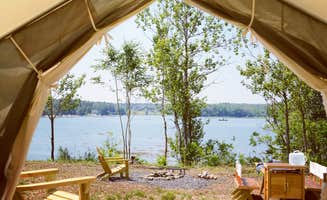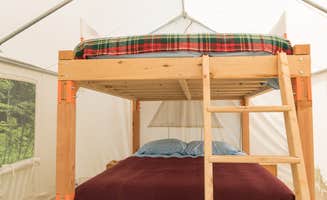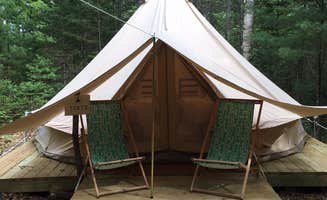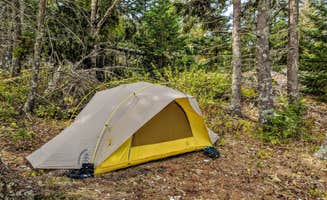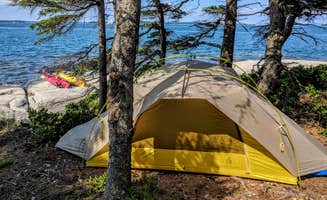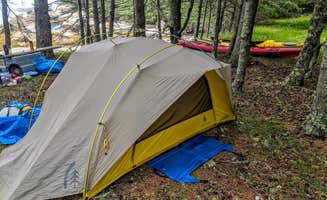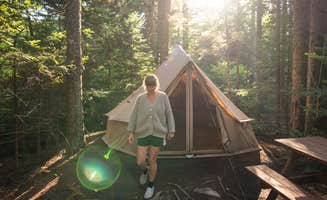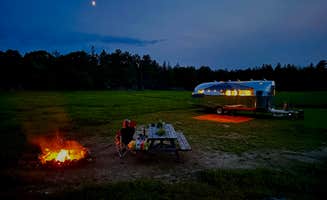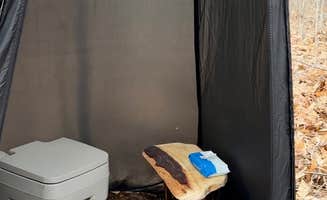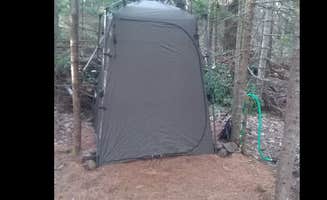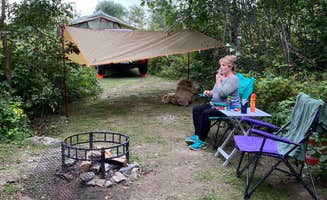Tent campsites near Owls Head, Maine range from small isolated islands in Penobscot Bay to farm-based camping experiences in the surrounding mainland. The region experiences significant tidal fluctuations between 9-14 vertical feet, which affects shoreline access for island campers. Winter temperatures can drop below freezing, with summer camping season typically running from late May through mid-October when temperatures range from 55-75°F.
What to do
Kayak to secluded islands: The Deer Isle Archipelago offers multiple camping destinations accessible only by water. From Stonington, paddlers can access islands like Saddleback Island, which features primitive camping spots with stunning views. "With a deep, rocky shore, it's the perfect place to make dinner and watch the sunrise or set, all with beautiful views of Mount Desert Island, the home of Acadia National Park," notes camper Shari G.
Hike Isle au Haut trails: Day trips to the remote section of Acadia National Park provide memorable hiking experiences. The Duck Harbor Campground serves as an excellent base for exploration. Patricia P. explains, "There are several miles of moderate hikes. Starting in 2018 reservations will be online starting April 1. The campground is open mid May to mid October but the mailboat only goes to the campground from late June to late September; otherwise a 5 mile walk from town."
Blueberry picking: Late July through early August is blueberry season, with several campgrounds offering picking opportunities. Maine Wild Blueberry Bliss provides campsites with direct access to rolling fields. One camper shares, "We absolutely loved this site, it was nothing we had ever experienced before. The views were incredible, we swam in the water everyday, and picked/ate the blueberries!"
What campers like
Island solitude: The Maine Island Trail provides opportunities for true seclusion on primitive camping islands. Nathan Island offers a basic backcountry camping experience with outstanding coastal views. One reviewer notes the simplicity: "The camping spot is simple and similar to most backcountry sites: a flat space to pitch your small tent, no toilet, no drinking water, no picnic table, and no reservations possible."
Rustic farm settings: Camping at working farms provides a distinctive experience with agricultural touches. Adam B. from Continuous Harmony Farm describes the setting: "The space is gorgeous, right next to a pond. Important to know though, there are several campsites. It's unclear how many campers could be there on any given night but it could be many."
Stargazing opportunities: With minimal light pollution, especially on the islands, night sky viewing is exceptional. A Saddleback Island camper mentions the natural beauty: "With a deep, rocky shore, it's the perfect place to make dinner and watch the sunrise or set, all with beautiful views of Mount Desert Island."
What you should know
Reservation challenges: Some campgrounds fill extremely quickly, especially the limited sites at Duck Harbor. Shari G. advises: "If you don't go online within 10 minutes of opening day, April 1st, at 10 am EST, you will miss your chance to stay here for the whole year. You won't be the first to get denied and certainly not the last."
Pack-in requirements: Most island campsites require bringing all supplies. For island camping at Shivers Island, campers must be self-sufficient: "You are required to use Wag Bags instead of digging a cat hole to dispose of human waste," explains a reviewer, noting that no facilities exist on most islands.
Weather preparedness: Coastal conditions can change rapidly, especially with fog. Paddlers need navigation skills and equipment. A Nathan Island reviewer warns: "The fog can roll in at any minute so come prepared with a chart, compass, bearings between islands/markers and a marine radio."
Tide awareness: Landing on islands requires careful timing due to significant tidal changes. At Shivers Island, one camper notes: "The tide in this area is significant (9-12 vertical feet), and landing at high tide is tricky/impossible on Nathan (and many other islands)."
Tips for camping with families
Pond-side camping options: Families often prefer sites with fresh water access. The Tiny Cabins of Maine offers tent sites with amenities that work well for children. One visitor reports: "The tent camping amenities, including the pop-up toilet and sturdy wooden platform, were thoughtfully provided. The fire pit and picnic table were perfect for evening gatherings, and the hammock added an extra touch of relaxation."
Multiple-site planning: For larger family groups, farms often provide adjacent sites. At Continuous Harmony Farm, a camper notes: "There are several campsites. It's unclear how many campers could be there on any given night but it could be many. The sites are not marked at all and there did not seem to be a way to check in."
Activity options: Look for campgrounds with built-in entertainment for children. At Tiny Cabins of Maine, one family enjoyed the variety: "We enjoyed the pub's games and even tried our hand at axe throwing. Kayaking in the pond was a highlight, thanks to the convenient dock."
Tips from RVers
Limited hookup options: Most camping near Owls Head focuses on tent camping, with minimal RV amenities. Four Acre Woods Campground provides some electric hookups, but sites are compact. A reviewer states: "All the things you need are there - firewood, water, bathrooms and showers, and even electricity at the site. Only thing is the sites are small and close together."
Dry camping preparations: RVers should prepare for boondocking at many locations. Heather C. from Maine Wild Blueberry Bliss describes their experience: "We stayed in campsite 2, where the land is open and flat, and there was plenty of room for our rv. It is dry camping, with no hookups, and generators are not allowed."
Generator restrictions: Most campgrounds in the region prohibit generators to maintain the natural setting. As one camper at Maine Wild Blueberry Bliss notes: "The area was very quiet - at night we only heard the crickets and the wind."


